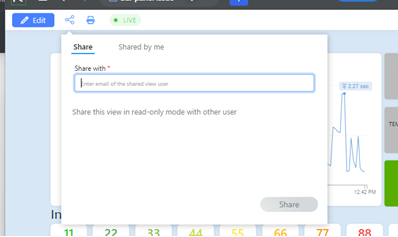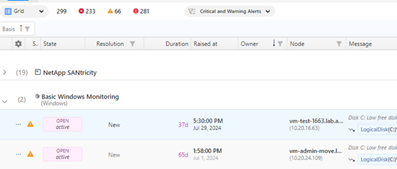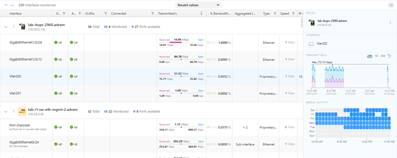NetCrunch 15.2 brings powerful new features and improvements designed to make your monitoring easier, smarter, and more flexible. From enhanced cloud email monitoring to Aruba device support and PRTG import capabilities, this update is packed with tools to help you manage and migrate your networks with greater efficiency.
NetCrunch 15.2 introduces new cloud email sensors designed to monitor cloud-hosted mailboxes using OAuth authentication. These sensors allow you to monitor mailbox availability, perform email round-trip tests, and analyze email data in modern, secured environments.
New alert types have been added to the Windows Service monitor, allowing you to track when services are installed or uninstalled on your monitored machines.
Two new monitoring packs have been added: Aruba Access Point (7 alerts) and Aruba Wired (7 alerts), providing out-of-the-box monitoring tailored for Aruba networks.
You can now easily migrate nodes from the main server to a probe, making transitions from on-premise installations to the cloud much smoother and more efficient.
NetCrunch 15.2 adds a new sensor for monitoring NAKIVO Backup and Replication, giving you better insights into backup operations and statuses.
We've strengthened NetCrunch's password security by improving the way user passwords are hashed and stored in XML files, making it harder for unauthorized access attempts.
NetCrunch 15.2 supports regular expressions for filtering syslog messages and SNMP traps, offering more precise alerting and easier management of incoming messages.
Physical segments monitoring now fully supports Aruba devices, enhancing network visibility and management for environments using Aruba infrastructure.
To support the growing number of users migrating from PRTG, NetCrunch 15.2 now offers a basic import tool. You can quickly bring in devices and essential sensors like PING. After import, NetCrunch can automatically detect and monitor additional services once you provide the necessary monitoring credentials, such as SNMP or Windows access.
We’ve significantly expanded the NetCrunch documentation with over 100 new and updated pages. The refreshed content covers:
Explore it all now in the online guide. We've made it easier to find, read, and apply — for both beginners and advanced users.
With the release of NetCrunch 15.2, all security vulnerabilities discovered in 2019 have now been fully resolved. The final issue addressed was the enhancement of NetCrunch’s password handling, which now supports long, strong user passwords. This marks the full closure of the 2019 security report from Compass Security. Below is a breakdown of resolved issues:
CSNC-2019-012 — Previously partially fixed. Now fully resolved in 15.2 with long password support
Compass Advisory – CSNC-2019-012
CSNC-2019-015 — (CVE-2019-14480) Previously partially addressed in v11.
Since v15, session IDs are longer, no longer exposed in URLs or headers, HTTPS is enforced, and the new console does not reuse legacy code.
Compass Advisory – CSNC-2019-015
CSNC-2019-016 — Previously partially fixed in v11.
As of v15, vulnerable JSON request method has been removed from the product.
Compass Advisory – CSNC-2019-016
Monitor the health and performance of IIS Application Pools effortlessly. Track states, worker process metrics, and ensure uninterrupted application availability.
NetCrunch introduces powerful new features for monitoring Windows processes:
NetCrunch now provides detailed insights into SSL-related issues by displaying error codes directly within the program.
These codes help you identify the exact type of SSL error, making it easier to troubleshoot and resolve connectivity or certificate problems efficiently.
NetCrunch now offers dedicated monitoring packs for Hyper-V virtual machine checkpoints, providing detailed insights into checkpoint statuses. Additionally, the Virtual Machines view has been upgraded to display a comprehensive list of checkpoints for better management and oversight.
We've refined the NetCrunch interface to make your experience even smoother:
Stay ahead of the upcoming Microsoft Teams API changes! NetCrunch now supports incoming webhooks for workflows, ensuring seamless Teams integration beyond January 2025.
This update is essential to maintain uninterrupted functionality as the old API is deprecated.
NetCrunch 15 offers versatile sharing options for Live Graphical Data Views:
Seamlessly embed shared live views into other webpages using iframes, similar to embedding YouTube videos.

NetCrunch 15 introduces critical security updates, addressing 7 key vulnerabilities:
Implemented mandatory password changes for web console users to ensure ongoing security.
You can force users to use MFA when they log in to the Web console locally or through the cloud.
Strengthened password policies, requiring new passwords to be at least 8 characters long.
The new Web Console mirrors the Desktop Console’s UI:
Create telemetry nodes to receive and process metrics, statuses, and events (logs):
The new Desktop Console offers:

Automated Screens have been enhanced and are now available in both the Desktop and Web Consoles:
Now you can quickly organize active alerts by simply enabling the group box. It’s a game-changer for staying on top of critical issues, making alert management more efficient and stress-free!

NetCrunch now monitors errors and discards on each monitored interface:
Why It Matters:
Monitoring these values helps prevent network issues before they escalate, ensuring smoother network performance and reliability.

NetCrunch 15 introduces a new Network Topology section within the Atlas, streamlining network visualization by combining two critical views:
This new section replaces the previous Physical Segments section and brings the Routing Map (formerly found in IP networks) and Physical Connections (previously a view in the Physical Segments section) together into a single, cohesive interface. This unified approach simplifies network management by allowing you to see both physical and logical relationships side by side, making it easier to understand and manage your network infrastructure.